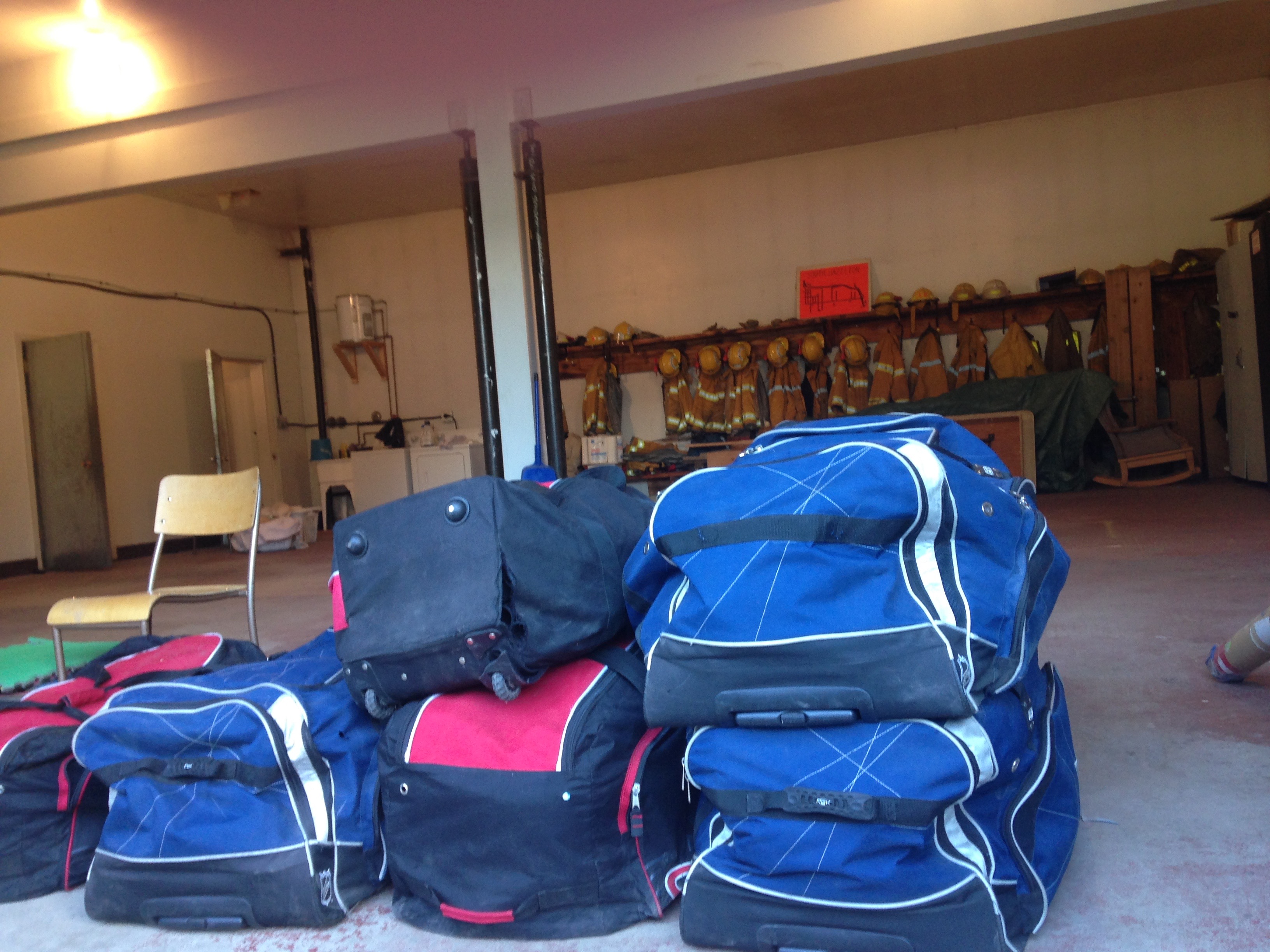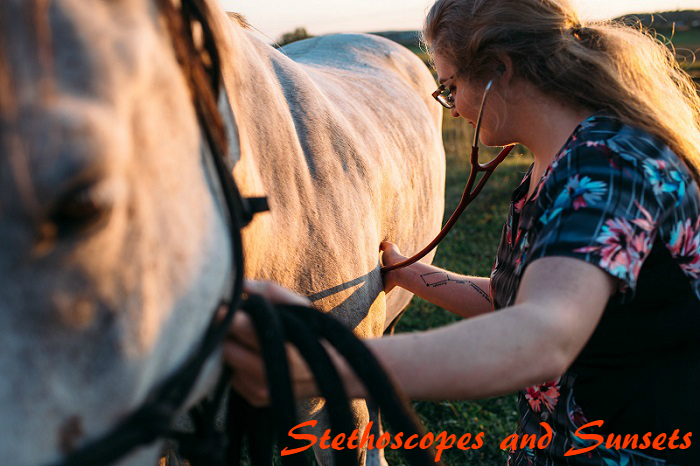
[The end of the trip and the entirety of our equipment packed away, leaving nothing more than an empty firehouse with a few disused sets of equipment on the wall where hours ago had been 50+ dogs, three surgery tables, two prep tables, a recovery area, a pharmacy, a makeshift reception table, and a crowd of people.]
In 2015, I went on a trip with the Canadian Animal Assistance Team to two small communities in northern British Columbia (Fort St. James and Hazelton). With 11 team members during the first round and 12 during the second, we sterilized and vaccinated two hundred and eighty two animals, along with performing an additional one hundred and forty one vaccination/wellness exams. The time will always stay in my mind as an example not only of the amazing camaraderie in the volunteering veterinary community, but also the incredible generosity of the communities which hosted, housed, and fed us along with bringing us their animals. To see so many people come together from so many different walks of life and unite in the common goal of improving animal welfare was inspiring. As Mahatma Gandhi once said, “In a gentle way, you can shake the world.” Our last day in Hazelton made that clear for me.
The last day dawns with a chill in the air, early summer cloud lingering over the mountains and threatening rain. Team members pour sleepily out of their rooms; some gnaw on apples or protein bars while others cling tightly to travel mugs overflowing with caffeinated goodness. The lockbox of controlled drugs get slung into the footwell of the ancient van. I flip my hoodie up over my ears. The front stoop of the old motel is a riot of multicolored scrubs and backpacks, stethoscopes and hair ties, a Tupperware full of the empties from last night. We ate fresh salmon and salt-and-vinegar chips, played games and stargazed and generally tried to forget that two days from now we’d be in real life. Now, in the cool morning, it feels startlingly real. I turn a slow circle and try to memorize the pattern of the mountains, the flickering motel sign, the cracked asphalt and the pines and the way the air tastes. I know I won’t remember it all. I still try.
The van manages to cough and sputter its way to our makeshift hospital, a disused fire station we’ve brought to new life with folding tables and blankets and as many crates as we can stuff in. The old office has become our staff room and at 7:30am it already overflows with food. Muffins and croissants from the 7/11 down the way sit piled on crockpots of soups and stews, cardboard boxes of cookies, veggie trays, urns of coffee…and everywhere, wrapped in tinfoil or cling or nestling in paper bags, everywhere there’s bannock. The community has taken the polite suggestion to contribute to our meals with a zeal I don’t think I’ve ever seen before; I haven’t eaten this well since I lived at home. But there’s no time for a leisurely breakfast. Dogs are lining up at the door, the arched ceiling of the garage is echoing with barks and howls, and I have to content myself with a Styrofoam cup of coffee with a little too much sugar and half a bannock wrapped in a napkin and shoved deep inside a scrub pocket. There’ll be time later, I promise myself.
Of course there isn’t — or there is, but there always seems to be something else that needs to be done. My usefulness at the prep table is limited after an unsuccessful attempt at feral cat-wrangling two days earlier ended with a set of fangs sunk deep into the knuckle-joint of my index finger. Despite judicious use of antibiotics and Advil I’ve still got a right-hand the approximate size and usefulness of a cantaloupe so I regretfully trade IV catheters and one-handed intubations for my stethoscope and an already anesthetized patient. Freddie Mercury shakes the rafters as my vets fly through surgery and surgery and before I know it hours have gone by and someone’s shaking my shoulder, offering to spell me off for lunch.
Lunch somehow leads directly to masticating a mouthful of makeshift sandwich (bannock, peanut butter, and homemade huckleberry jam, there is no chef alive who can make something as delicious) while I recover patients. I tug on tongues and pinch toes, whistle into ears, somehow end up the center of a little ring of patients in various stages of anesthetic recovery. A puppy snores gustily by my left leg. My right boot props open the door of a cat kennel so I can keep an eye on the snoozing contents, an orange tom with cheeks so huge it’s a wonder he can even see past his own testosterone. My useless right hand sits on the ribcage of a dog that’s almost certainly half-bear (judging by the size and hairiness factor, at least) and my left passes my stethoscope over to my six-year-old shadow, all dark hair and bright smile as she listens to the heartbeat of the family dog. We count his pulse together before she places the bell on her own chest and her mouth opens in a perfect O of surprise; there is no difference between what beats in her chest and what beats in his.
In true veterinary fashion the end of the day brings something of an unwelcome surprise. A small, elderly spay has a belly covered in mammary tumors, hard nodules of tissue poking up between her nipples. My veterinarian has a soft conversation with the owner; I pretend I’m not eavesdropping as I glance at my watch and then at the little gray muzzle in front of me. She pants brightly, far more interested in the commotion of people than her fate. I can’t hear what he’s saying. I imagine it instead, how she must be talking about things like prognosis and risks and how no matter how you slice it an old girl on the table with nothing but a saline drip and a syringeful of anesthetic drug is tricky enough without trying to take off multiple masses as well. The owner stands steady. They know the risks. They accept them. The little gray muzzle moves from my arms to the prep table. So, so, so.
There’s a brief but intense conversation among the techs about who’s going to monitor her surgery. It’s certainly not going to be pretty — all hands on deck, someone says, and we all laugh a little but she’s not wrong — and the stakes are high and we all know what the outcome might be. In the end it’s more a team effort than anything else, techs rotating in and out of clean-up duty as our makeshift surgery table becomes the last remaining sign of our presence here. It’s a long and bloody procedure that sees me wiping arterial spray off the paperwork (and my face) more than once but gradually muscle and skin come together until finally my vet is putting in the last sutures and I’m pulling the endotracheal tube and our little old lady is blinking her way hazily back to consciousness in her owner’s arms.
The last hour of teardown goes quickly. Our blood-spattered table gets wiped down and packed away with whatever’s left of the saline and the surgical instruments we washed in the laundry sink. Towels are folded, enormous duffel bags are crammed to bursting, and the last of the food mountain is devoured or stuffed in pockets for later. Throughout it all I keep half an ear out for the little dog still dozing quietly on her owner’s lap, settled on a chair in the middle of the room. By the time the last of the other patients are stumbling out the door, newly-vaccinated and missing some reproductive anatomy she’s holding her head up and peering around with rheumy eyes. When I go to check her color she laps at my hand. The rush of warmth and good-feeling lasts just until I lift a leg and peek at her incision only to find myself suddenly fending off yellowed canines that snap industriously at my swollen fingers. So much for gratitude.
I think about that later, on the plane ride home. It’s a question that bothers me sometimes, the ethical quandary of do I do this to help or do I do this to soothe my own ego? There have been plenty of these debates in the human world regarding charities and humanitarian missions, the good they do versus the harm. And I can’t deny that it does carry with it a rush — the feeling of working without the bells and whistles of normal practice, the pride of dozens of surgeries a day, the warmth that comes with the offers of food and heartfelt thanks from people who won’t have to feed another litter — or consider what to do with it. But no matter what I keep circling back to the animals.
Our work makes a difference to them. There’s no denying it. Each animal we sterilize will benefit from it, whether it’s the females who won’t have to carry litter after litter to term at the expense of their bodies or the males who won’t contribute to the overpopulation. The females won’t die of pyometra or mammary cancer. The males won’t die of prostate or testicular cancer. Pups and kittens won’t die of starvation, distemper, parvovirus, panleukopenia, rabies. Each animal we vaccinate is another stone in the protective wall known as herd health.
And one old dog of indeterminate breed won’t live in pain from the ulcerated masses of tissue which were her teats. She doesn’t know that. She bites at us, these strangers who poked her and prodded her and gave her drugs to make her feel strange, to touch her while she’s in her person’s lap. She doesn’t know the difference. She never will.
But I do.
